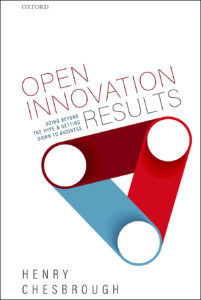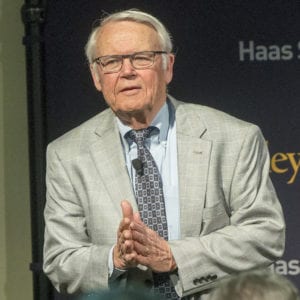 When Adj. Prof. Henry Chesbrough, PhD 97, was researching open innovation in the pharmaceutical industry, he found one pharma that had 7,000 scientists working on tens of thousands of compounds. But the company only licensed out less than one a year, shelving the others.
When Adj. Prof. Henry Chesbrough, PhD 97, was researching open innovation in the pharmaceutical industry, he found one pharma that had 7,000 scientists working on tens of thousands of compounds. But the company only licensed out less than one a year, shelving the others.
Although some of those shelved compounds may have succeeded in the marketplace, companies may fear they’ll look bad if a product they passed on thrives externally—a phenomenon he calls “Fear of Looking Foolish” or FOLF. “Our interview subjects admitted to us that FOLF was a major constraint to overcoming this,” Chesbrough writes.
It’s been 16 years since the publication of Chesbrough’s Open Innovation launched a new paradigm for bringing new technologies to market, spurring companies to embrace the power of collaborative business models.
 Chesbrough is back to close the loop with his most ambitious work to date. Open Innovation Results: Going Beyond the Hype and Getting Down to Business (Nov. 2019, Oxford University Press) offers a clear-eyed view of the challenges that limit organizations’ ability to create and profit from innovation and practical tools for overcoming those challenges.
Chesbrough is back to close the loop with his most ambitious work to date. Open Innovation Results: Going Beyond the Hype and Getting Down to Business (Nov. 2019, Oxford University Press) offers a clear-eyed view of the challenges that limit organizations’ ability to create and profit from innovation and practical tools for overcoming those challenges.
The book also provides a roadmap to restore productivity and economic growth for society as a whole—in the U.S. and globally.
David Teece, the Thomas W. Tusher Professor in Global Business, says Open Innovation Results breaks new ground. “It links open innovation not only to enterprise performance but to national economic growth as well,” he says. “There are important insights into the difference between ‘open’ and ‘free’ innovation, along with insightful characterizations of China’s use of open innovation practices and policies.”
Open innovation centers on the idea that companies stand more to gain from making use of external ideas and sharing their own innovations through licensing, sales, partnerships, and spinoffs than from trying to do it all themselves. A famous example: IBM’s development of the PC.
“We wanted to do something small and fast…so it was critical to IBM’s success that we partnered with Intel and Microsoft and created the PC industry together,” said Jim Spohrer, Director of Cognitive OpenTech at IBM and a member of the Berkeley Innovation Forum, a group created by Chesbrough to help corporate managers involved in innovation.
Has the promise of innovation been overhyped?
Chesbrough opens the book with an “exponential paradox” that’s at the heart of our current global economic situation: While new technologies are emerging faster and faster—some say exponentially—economic productivity is slowing. Has the promise of innovation been overhyped?
The real problem, Chesbrough argues, is that promoters of innovation too often chase after “bright and shiny objects,” focusing on the initial stage of development and neglecting the rest of the process. Innovation results depend on what you finish, not on what you start, he says.
“In order to advance prosperity, we must not only create new technologies, but we must also disseminate them broadly and absorb them, which means having the knowledge and skills to put them to work in our business,” Chesbrough says. “Only then do we really see the social benefit of these new technologies, and only then will these measures of economic productivity catch up again.”
Chesbrough shapes these three facets of innovation—generation, dissemination, and absorption—into a new paradigm for managing R&D and bringing new technologies to market. Rooted in two decades of extensive field research, the book is packed with real examples of successes and failures from companies such as Procter & Gamble, IBM, Intel, General Electric, Bayer, and Huawei.
Carlos Moedas, the European Union’s Commissioner for Research, Science, and Innovation, says the book’s complex concepts are easily relatable. “[It’s] a must-read for politicians, policy-makers, and business leaders who want to make a difference by designing the right policies that drive not only the generation of new ideas, but…their broad dissemination and adoption by society,” he says.
About Henry Chesbrough
Henry Chesbrough is widely known as “the father of open innovation”. He has built an international reputation for his insights into the innovation process. The author of six books (translated into 12 languages) and numerous articles, he has received 70,000 citations to his work on Google Scholar. He has appointments at both UC Berkeley’s Haas School of Business and at Esade Business School in Barcelona.
Prof. Chesbrough founded and organizes two external groups of companies that each meet twice a year to discuss challenges in managing innovation: the Berkeley Innovation Forum (32 member companies) and the European Innovation Forum (20 member companies). He has taught at the Haas School of Business for the past 14 years, at Esade Business School for the past 7 years, and taught previously at Harvard Business School for 6 years. He also serves as the Faculty Director of the Garwood Center for Corporate Innovation at Berkeley Haas.
Open Innovation Results is available for pre-order on Amazon.

